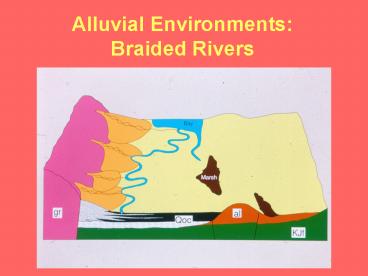Alluvial Environments: Braided Rivers - PowerPoint PPT Presentation
1 / 14
Title:
Alluvial Environments: Braided Rivers
Description:
Alluvial Environments: Braided Rivers Composicion: siliciclastic, but all types of clasts are possible (compositionally more mature than alluvial fans greater ... – PowerPoint PPT presentation
Number of Views:427
Avg rating:3.0/5.0
Title: Alluvial Environments: Braided Rivers
1
Alluvial Environments Braided Rivers
2
- Composicion siliciclastic, but all types of
clasts are possible (compositionally more mature
than alluvial fansgreater distance of transport)
3
Types of rivers straight (rare), braided, and
sinuous (one stable channel with meanders)
4
Texture moderately well sorted, moderately
rounded (but variable), clasts of many sizes
5
Structures Poorly developed graded beds, much
cross stratification of medium scale,
subhorizontal beds with imbricated clasts
6
Geometry of deposit long and narrow (depends on
form of the valley), channels are generally
narrow and shallow, interchannel deposits are
planar and finer grained than in channels
Wide valley with many channels
Narrow valley
7
Channel banks are unstable (change frequently)
Ephemeral discharge
8
Lateral variacions alluvial fans (up slope)
meandering rivers (down slope), glaciers, lakes
9
Vertical sequence beds of gravel and sand with
erosive bases (channels) interstratified with
finer sediments (interchannel areas)
10
Biology bones of terrestrial animals, pieces of
terrestrial plants (generally preserved only in
the fine-grained interchannel sediments)
Chemical processes often have red or orange
colors because of iron oxidation in subaerial
environment soils developed in interchannel
areas
Red beds, Andes Mountains
11
Processes of deposition?
12
Processes of deposition traction flows (much
bedload) clasts roll and saltate (imbricacion),
bar migration in channels (planar and trough
cross stratification), migration of shallow
channels (poorly developed fining-upward
sequences) suspension (ripples and plane
bedsinterchannel areas)
13
Depositional setting moderate relief and slopes,
any climate type, high sediment supply
14
Erosive channel bases (well-defined contacts with
underlying beds)































